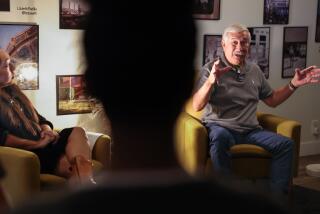Schoolchildren are being taught not to play on the railroad tracks in Compton, where trains run right through the middle of town.
Young Juan Mosquedasays he does not play on the railroad tracks in his Compton neighborhood. But the 10-year-oldâs friends sure do, and he has been known on occasion to watch.
âSome of my friends stand on the tracks and try to make the trains stop,â said Juan, a fifth grader at Robert F. Kennedy Elementary School. Others, he said, simply like to throw rocks as the freight cars make their way down the tracks on Alameda Street.
Children might inherently be attracted to the mixture of dirt, rocks, power and noise that trains and their environs provide, but it is an instinct that Naomi Nightingale is going to throttle if she can.
Nightingale is the areaâs community relations manager for the Los Angeles County Transportation Commission. One of her jobs is to teach school children not to play near railroad tracks. That is especially important now in Compton, she said, because of construction of the Long Beach-Los Angeles light rail passenger line, a section of which is being built next to the existing freight tracks in Juanâs neighborhood.
Nightingale went to Kennedy Elementary last week and told the kindergarten through fifth-grade children about the kinds of dangers that the light rail construction will bring.
She brought second grader Julie Jones before one group to demonstrate what could happen to children who journey into the work area.
Too shy to move her gaze from the tops of her shoes, Julie was outfitted in a hard hat as Nightingale queried the youngsters about the dangers they might expect.
âIf Julie was out there playing and a big truck or a big piece of equipment was coming right at her, it wouldnât see her, would it?â she asked the children.
âNo,â they answered exuberantly.
Later, after Julie had slipped back to her seat, Nightingale asked the children what they thought would happen if one of the machines ever hit them.
They replied with a muffled âwe would die.â
The children are told they must stay clear of the track area while the light rail is being built and they should not cross any railroad tracks except at intersections.
The $798-million light rail project is expected to be completed in 1990. It will carry passengers the 21 miles between Long Beach and downtown Los Angeles in 55 minutes. Construction in Compton began in March, while city and LACTC negotiators hammered out a compromise agreement over the routeâs north-south design.
Compton had repeatedly tried to stop the project for fear that the trolley would combine with existing freight trains to bisect the city, causing traffic snarls and blocking emergency vehicles attempting to cross the tracks. But in September, the City Council signed an agreement that calls for diverting freight traffic away from the light rail line and also using a combination of state and county funds to build an overpass for vehicles on Rosecrans Avenue at Alameda Street. Transportation commissioners, however, are yet to add their approval.
Between sessions at Kennedy Elementary, Nightingale said she is certain the program is having an effect on the children. It includes a lesson plan for classroom teachers, visual devices such as coloring books and a video cartoon, and letters about safety to parents.
The program also has Travis the Owl, an animated mascot whose jingle âSafety for Whoo, Safety for Youâ was sung enthusiastically by the children.
âWe havenât had the program long enough to make claims (about its effectiveness) and substantiate them,â Nightingale said. âBut when Iâm out there in the neighborhoods, the children remember me and remember what I told them.â
Kennedy was the 14th of 55 schools Nightingale and her crew will visit. She also visited the school last year to discuss train safety.
She said the biggest problem is that railroad tracks have been in the area longer than most of the residents and are second nature to many of them.
âIt is really hard when you see a parent, kid in hand, breaking all of the rules,â such as crossing the middle of the tracks, Nightingale said.
Fourth grader Unooyalyn Greham, who lives so close to the tracks âMy house shakes when a train goes by,â said she noticed a change in her peersâ behavior after Nightingaleâs last visit.
âSome kids used to let the trains get this close,â holding her hands inches apart, âbefore getting away from the tracks,â Unooyalyn said. âBut now they look to see if the trainâs coming and they watch out for the machinery.â
More to Read
Sign up for Essential California
The most important California stories and recommendations in your inbox every morning.
You may occasionally receive promotional content from the Los Angeles Times.










